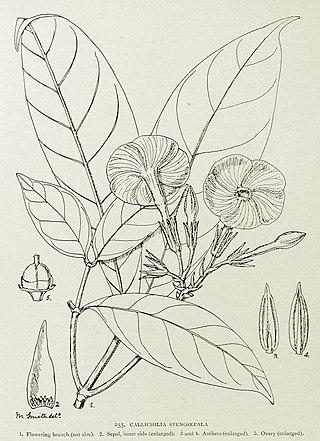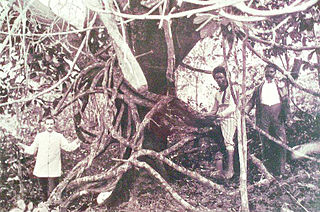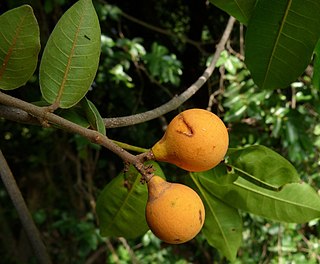Prioria balsamifera, the agba or tola, is a tall forest tree in the family Fabaceae. It is native to lowland tropical rainforest in west Africa, from Nigeria southwards to the Congo basin in Angola, Cameroon, Republic of the Congo, Democratic Republic of the Congo, Equatorial Guinea, Gabon, scattered or in local pockets, favouring deep soil and plenty of moisture. It is threatened by habitat loss and over-cutting for timber.

Herpele squalostoma is a species of caecilian in the family Herpelidae. It is also known by the common name Congo caecilian. It is found in Central and extreme easternmost West Africa.

Anubias heterophylla is a species belonging to the Aroid genus Anubias. It was first described scientifically by Adolf Engler in 1879.
Landolphia kirkii is a species of liana from the family Apocynaceae that can be found in Democratic Republic of the Congo, Malawi, Mozambique, Tanzania, Zambia, Zimbabwe, and in the KwaZulu-Natal province of South Africa.
Adenorandia is a monotypic genus of flowering plants in the family Rubiaceae. It was described by Vermoesen in 1922. The genus contains only one species, viz. Adenorandia kalbreyeri, which is found from west-central tropical Africa.

Callichilia is a genus of plant in the family Apocynaceae, native to tropical Africa.
Cylindropsis is a genus of plants first described in 1898. It contains only one known species, Cylindropsis parvifolia, native to central Africa.

Landolphia is a genus of flowering plants in the family Apocynaceae first described as a genus in 1806. They take the form of vines that scramble over host trees. Landolphia is native to tropical Africa.
Anubias gilletii is a plant that was first described scientifically in 1901 by Émile Auguste Joseph De Wildeman and Th. Durand.

Anubias hastifolia is a species belonging to the Aroid genus Anubias. It was first mentioned by Adolf Engler in 1889 and described scientifically by him in 1893.

Landolphia owariensis is a species of liana from the family Apocynaceae found in tropical Africa. Latex can be extracted from this plant for the manufacture of natural rubber. Other names for this vine are eta, the white rubber vine and the Congo rubber plant. Congo rubber was a commercial rubber exported from the Congo Free State starting in 1890, most notable for its forced harvesting under conditions of great human suffering, in the Congo Free State, detailed in the 1904 Casement Report. From 1885 to 1908, millions died as a result of murder, deprivation, and disease, with population falling by millions in this period; some writers estimate this loss to be as high as 10 million people.

Brachystegia laurentii, a plant in the family Fabaceae, is a species of large tree found in western Cameroon, Gabon, Equatorial Guinea, the Democratic Republic of the Congo and the Republic of the Congo. It has a dense, umbrella-shaped crown. The wood is known as bomanga and has many uses in building and construction.

Strychnos camptoneura is a species of plant in the Loganiaceae family. It is native to Camaroon, the Central African Republic, the Democratic Republic of the Congo, Gabon, Ivory Coast, Liberia, Nigeria, the Republic of the Congo and Zaire.
Strychnos icaja is a species belonging to the plant family Loganiaceae, native to West Tropical Africa. It is a very large, tropical rainforest liana which may attain a length of 100 m (330 ft).

Alstonia congensis, is a tree within the Apocynaceae family and one of two African species within the Alstonia genus, the other being the Alstonia boonei De Wild. Both have similar morphological characteristics.

Landolphia heudelotii is a climbing shrub or liana that is within the Apocynaceae family, it occurs in the Guinea and Sudan savannahs of West Africa and cultivated for its rubber and edible fruit.
Landolphi mannii is a liana within the Dogbane Family (Apocynaceae). It is commonly called Jungle chocolate or Malombo. Its fruit, with significant lipid and iron content is consumed by locals and it is also a part of the diet the Mandrillus sphinx.
Landolphia buchananii is a liana within the Apocynaceae family. It is sometimes called Nandi rubber in English and known locally as Mugu among Kikuyus. Occurs in savannahs and montane forests in East Africa and Southeastern Nigeria.
Landolphia dulcis is a climbing shrub or liana within the Apocynaceae family.

Batesanthus purpureus is a species of plant in the Apocynaceae family. It is native to the Cameroon, the Central African Republic, Democratic Republic of the Congo, Gabon, Guinea, Ivory Coast, Liberia, and Nigeria. Nicholas Edward Brown, the botanist who first formally described the species, named it after its purple flowers.










